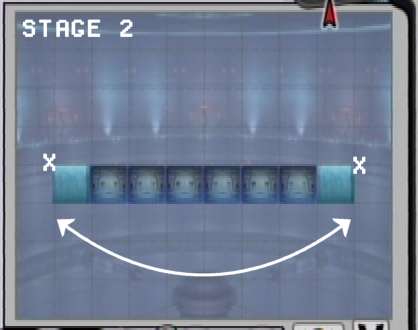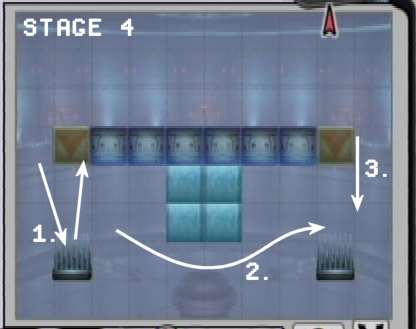The Super Smash Brothers Brawl's stage builder is a great teaching tool for the first lessons of the Designer's Workshop. Space in the editor is quantified into a grid, and making a stage is as easy as dragging the pieces around. Because a significantly large portion of Brawl's core design exists in matches with as little as a flat surface and two characters fighting it out, the designer doesn't have to do much to create a functioning level. With that said, from the flat stage base any element that's added can only influence the play experience in some way.
I image that all developers wrestle with designing influence in their games. After all, games are made of challenges, and you can't create a challenge that can be completed by doing nothing. By forcing the player to do specific tasks or actions to progress, challenges are created and structured. However, having only one strict way to beat a challenge can take away from the player's expression. Achieving a balance is always the goal.
Take Super Mario Brothers for example. Collecting coins is completely optional. Yet, the way the coins are arranged in each level encourages the player to JUMP for them (the primary mechanic of the game). Pits, enemies, and other obstacles require the player to JUMP over them. If the player doesn't JUMP and JUMP well, they'll either die or sustain damage. Do this too many times, and you'll fail.
Super Smash Brothers Brawl is somewhat unique because it's a fighting game. Technically, the player has access to a wide range of mechanics and moves yet none are required to win. Though it is highly unlikely, the opponent is capable of finishing themselves off. Even without taking such an extreme view on the game, it is possible to beat an opponent with just one move. In this way, the challenge in a fighting game is contained almost entirely between the players. So, we don't have to worry about creating a challenge by forcing players to use mechanics in any specific way. We only have to consider how we can influence gameplay.
This is the point where having a solid understanding of the core design/mechanics of Brawl is necessary. For this exercise, I'm attempting to influence the strategies used in a tournament level match between a Kirby and a R.O.B. through level design.

On this basic stage it is not an uncommon strategy for a R.O.B. player to retreat in one direction while shooting lasers and launching the spinning tops in the opposite direction and at the opponent (1). Once R.O.B. backs up to the edge of the stage, he maintains a strategic advantage by jumping off the stage and grabbing onto the ledge (2). By jump up off the ledge and falling back down to grab it again, R.O.B. can continuously reset his invincibility time. All characters can do this, but this strategy can be particularly effective with R.O.B because he can continue to use some of the best projectiles in the game while repeating this strategy.
The problem I have with this strategy is that it takes away a lot of the possible interactivity between the two players. A character like Kirby, with his limited speed, range, and power, has a hard time countering a R.O.B. using this strategy. The R.O.B will either shoot Kirby from the ledge, hit Kirby away taking full advantage of his invincibility frames if Kirby gets too close, or retreat to the other edge of the stage by traveling above or even below the stage. Ultimately, though playing like this is well within the R.O.B. player's freedom, it removes a significant amount of the interactivity and interplay from the match and therefore the gameplay
Normally, tournament runners create rules whether explicit or understood, that encourage players to play in such a way that the community deems fair while exhibiting a certain level of sportsmanship. This is why glitches where one player can indefinitely freeze their opponent so that they can't fight back as the damage is racked up are banned.
I feel that games can be designed in such a way where the gap between playing to win (tournament play) and playing for fun isn't very big at all. Though I can't redesign the core design of Brawl, I can design a stage that encourages other strategies by designing interplay and/or possible for counter strategies for both characters.

Notice in this variation on the Stage 1, I changed the side blocks into ice blocks which don't feature edges that can be grabbed onto. This eliminates the invincible ledge camping strategy. Now, both players have to move up and over the edges of the stage to land back on solid ground. This isn't a problem for Kirby's multiple jumps or R.O.B.'s Robo Burner recovery move. By simply taking away the edges, players have to fight to outsmart their opponents who are busy trying to keep them from landing back on the stage. The gameplay for this variant actually contains edge guarding and off guarding, two strategies reminiscent of Super Smash Brothers Melee tournament level gameplay.
There's still the possibility of R.O.B avoiding landing on the closest edge and opting to fly underneath the stage to come up and over the other side. Perhaps we can make this avoidance option more interesting.

Now Kirby and R.O.B have to conserve their jumps and rocket fuel in order to travel underneath stage 3. The four ice blocks hanging on the underbelly of the stage create a nice aerial speed bump giving the player on top enough time to run to the other size of the sage and mix things up.
Without any kind of edge to grab for safety, perhaps staying on the stage and repeatedly knocking the opponent back off is too effective. Let's explore a variant that will encourage players to leap off the stage and battle in the underbelly.

Stage 4 contains spikes that damage the player when touched (1). Players can land on these hazards and take a hit in order to help them recover some height and their jumps to try and make it back to the stage. Now, traveling beneath the stage isn't as risky because of how the spikes can aid recovery (2). The player on the stage can dynamically change the space around the spikes by standing on the orange blocks at the edge of the stage. Stand on these blocks for a second, and they'll begin to fall out of the sky (3). With a little timing, player can trap opponents looking to use the spikes to their advantage. Dropping the blocks in this way, though, temporarily shortens the stage making it a little easier for players to get back on top off if they see through your plan.
All of the strategies and counter strategies (interplay) created from the arrangement of level elements in stage 4 is very interesting. Just for the sake of this exercise, there are changes that can be made to stage 4 that would deemphasize the combat on top of the stage, and encourage more combat on the edge and underneath. Such a stage would look like this...

The conveyor belts work to move the fighting to the sides of the stage which are designed to drop the battle beneath the stage (1). The only simple, non dynamic part of the stage is the small center area (2). Good luck trying to keep the battle in that small space.
The true test of the design of these stages will be measured next Tuesday when I will battle a tournament R.O.B. player. I'll be sure to capture the footage and include the results in this workshop.
This concludes the Designer's Workshop exercise for Super Smash Brothers Brawl. For this exercise, we touched on the first three steps of the designing process:
- Mapping the range of mechanics
- understanding the limitations of the editor
- influencing styles of play and strategies
In the next lesson, I'll walk through the first three steps in a little more detail with Bangai-O Spirits in addition to covering the fourth step: creating a game idea.